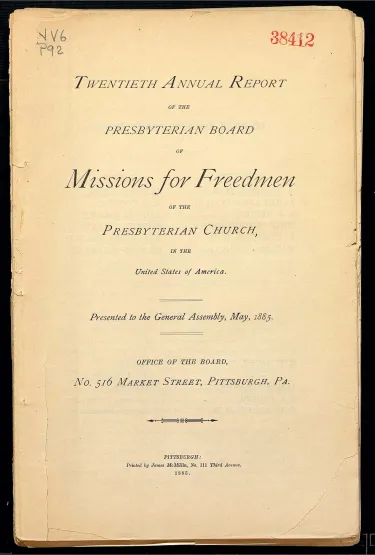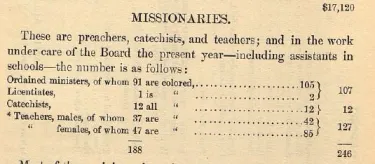This blog is a continuation of the Presbyterian News Service article of the same name. We suggest you read the PNS piece first, and then revisit this blog.
--
At the Presbyterian Historical Society, we house the records of the United Presbyterian Church in the U.S.A.’s (UPCUSA) Board of Missions for Freedmen. Before being formally incorporated in 1883 and becoming the Board of Missions for Freedmen, the group was called the Committee of Missions for Freedmen, or the Freedmen’s Committee, and was created in 1865 at the end of the Civil War.
The goal of both Committee and Board was to support formerly enslaved people in pursuing an education and career, namely through the training of teachers and preachers. Through fundraising, it built and supported Black schools, churches, colleges and seminaries throughout the southern U.S. In 1923, the Freedmen's Board was one of several boards and agencies which merged to become the Board of National Missions.
--
In the committee’s first annual report, published and circulated in May 1866, much information can be gleaned. They share statistics, hopes, requests for funds, and more.

Starting on page twelve is a section titled “The Work and its Hindrances.” Here, we learn that, “By the report of the last census, there are almost four millions of freed people.” We also glean that “There were reported to the Assembly of 1860, nearly 14,000 colored communicants, and the great body of them must now be found among the Freedmen.”

The hindrances listed had much to do with the ongoing discrimination and racial prejudices that characterized the Reconstruction Era, as well as the reality that the formerly enslaved were now “without certain homes, and must, of necessity, be drifted about for some time to come” and that “their poverty prevents their doing much for their churches or schools.” The missionaries and those being taught and assisted faced heightened hostility from the folks around them, saw a number of school houses go up in flames, and were ostracized and alienated by their communities.

What progress would they make in the years to come? How would the following year’s report evolve to reflect the ever-changing landscape of post-Civil-War and post-Juneteenth America?
We’ve got the receipts here at PHS, in the form of these annual reports, as well as the various other memoranda that exists within the collection.
Let’s see how the committee is faring two decades down the line in their twentieth annual report.
--

The first annual report was 34 pages; the twentieth annual report has 90. Right away, we learn of their progress—“The Presbyterian Board of Missions for Freedmen respectfully presents to the General Assembly its Twentieth Annual Report, and in doing so, would record the goodness of God in making it one of the most successful years of our work among the Freedmen,” the introduction reads.
A brief history of the committee followed, as well as statistics and a treasurer’s report, before readers are given an update on the current situation of the board:
From a very small beginning twenty years ago, [the Board] shows to-day by its Twentieth Annual Report 198 churches with 11,372 communicants, 194 Sabbath schools with 13,449 scholars, 77 days schools, 3 chartered institutions, 3 normal and 2 graded schools with 8,746 pupils, 246 missionaries, 6 presbyteries and a synod, under its care.
A few institutions are mentioned by name that might ring a bell: Biddle University in Charlotte, N.C. being one of them, Barber Scotia Seminary in Concord being another.

The report concludes:
We cannot close this report in fitter or more impressive words than those used by your venerable body in the first paper adopted on the "Religious Education of Freedmen," viz. : "The Presbyterian Church must be true to its historic doctrine and faith, that the hope of the African race, under God, is in Christian Education, and in the liberty wherewith Christ makes his people free, and not in the possession of civil privileges alone."
For many, proclamations and amendments were simply words. And so, on Juneteenth, they celebrated—they ate and danced and sang together, came together in joyful noise as they gloried in the passing of the past into this present moment—but they continued to watch for the actions that would follow. Practices like sharecropping, lynching, and targeted law enforcement allowed the peculiar institution of slavery to continue on in many forms, well past the ratification of the 13th Amendment. But, at the same time, new schools and sanctuaries were being created with the support of organizations like the Committee, who helped craft new spaces in which the formerly enslaved could stretch and grow and learn.
It has taken many years of social and intellectual activism by major figures like Octavius V. Catto , James W.C. Pennington (both ordained Presbyterian ministers), W.E.B. Du Bois, and so many more to further the evolution of what it means to be free in the United States. Juneteenth is a way to celebrate, not just emancipation, but the many battles that have been won while also reminding us that there are yet many to fight.
You may freely reuse and distribute this article in its entirety for non-commercial purposes in any medium. Please include author attribution, photography credits, and a link to the original article. This work is licensed under a Creative Commons Attribution-NonCommercial-NoDeratives 4.0 International License.




